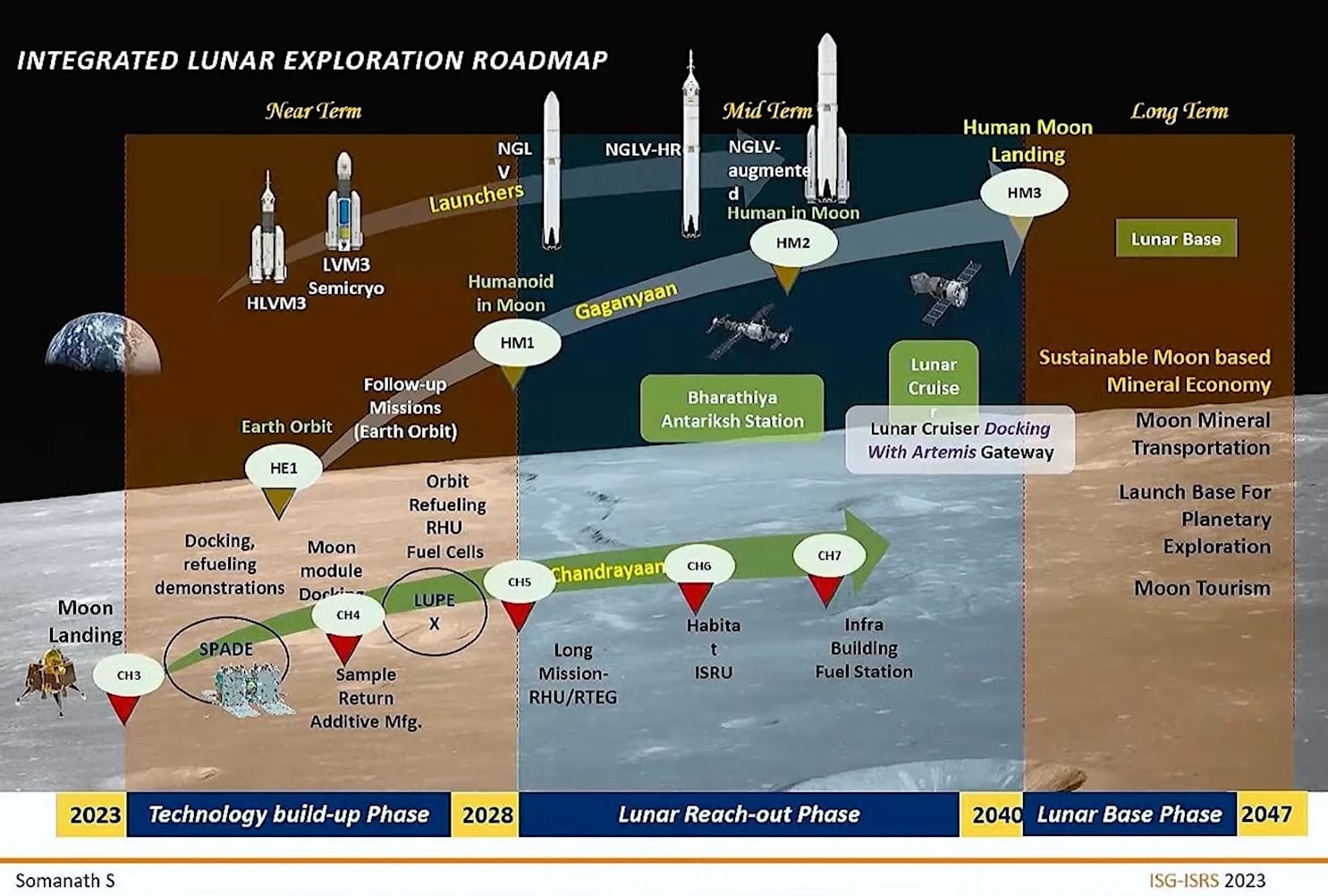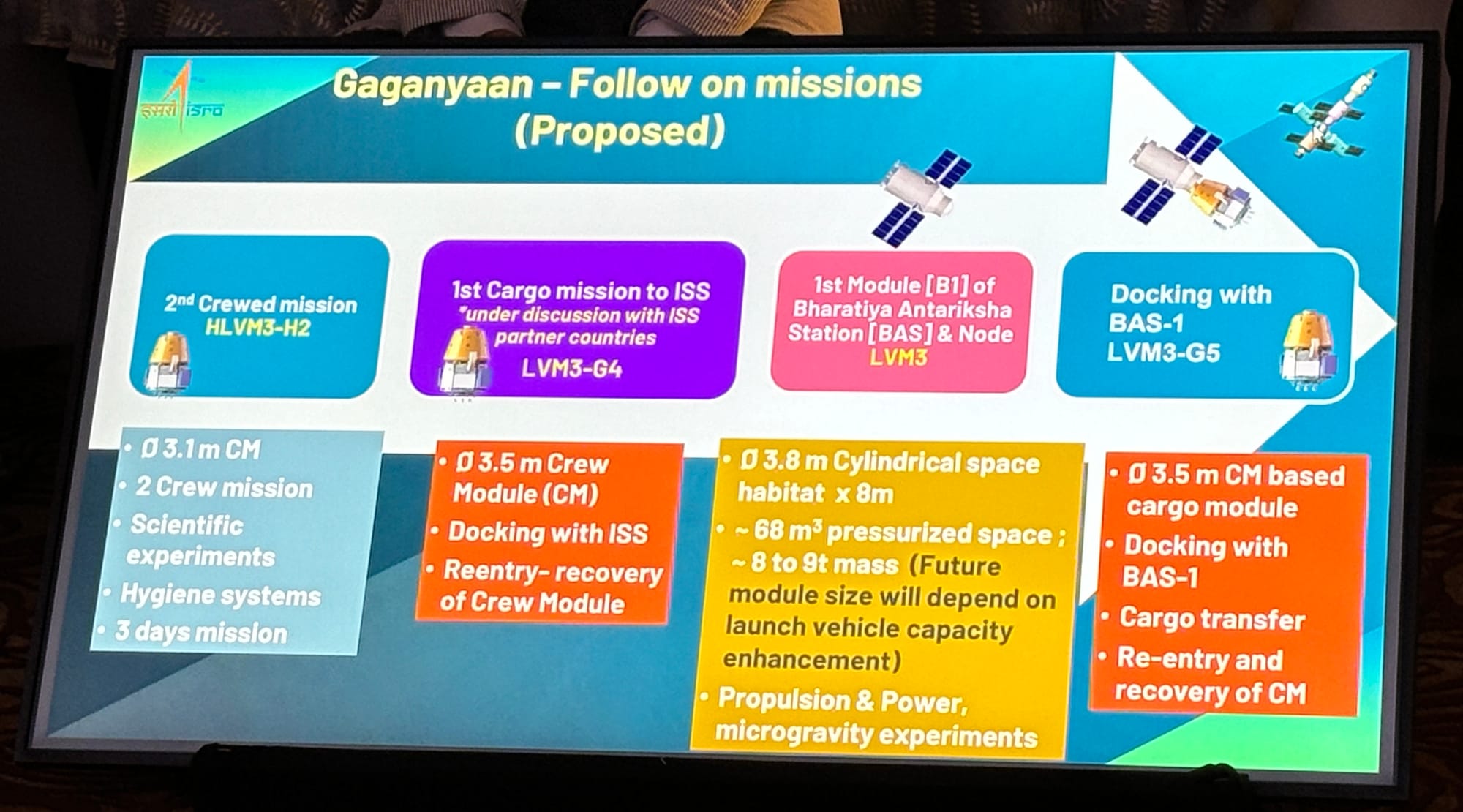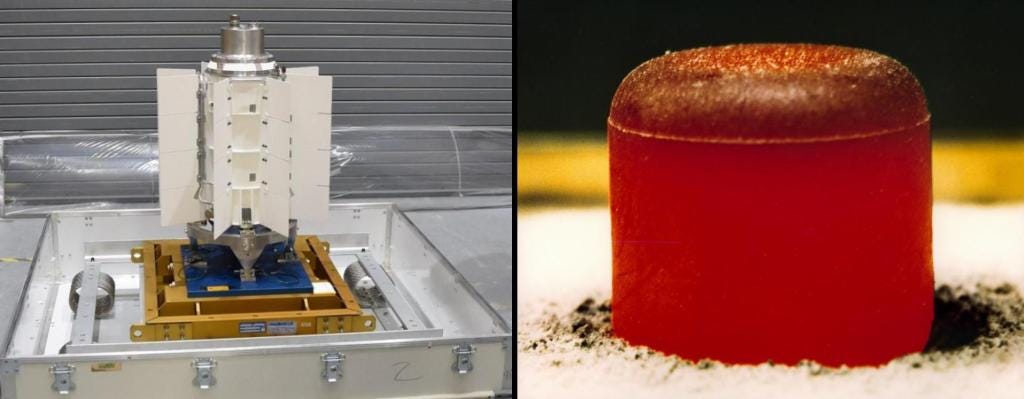Moon Monday #183 and Indian Space Progress #17: The one where Chandrayaan and Gaganyaan converge
How will ISRO go from Chandrayaan 3 to an Indian on the Moon? Clarifying and laying down India’s plans for increasingly complex robotic lunar missions, where human spaceflight comes in, and what realistic timelines look like.
The successful touchdown of Chandrayaan 3 on the Moon last year was pivotal for India’s space ambitions as well as for global lunar exploration. Having taken place amid many lunar landing failures, Chandrayaan 3 kept the worldwide momentum for the Moon going by feeding into the frenzy of sending robotic explorers to our cosmic companion. Chandrayaan 3 changed perceptions developed space powers had of India’s ability to explore space beyond Earth orbit. Internally too, paired with the new national space policy, the Moon landing signaled the Indian government to let ISRO not only double down on lunar exploration but go many steps further and develop a roadmap for human spaceflight which converges with Chandrayaan at the Moon—best highlighted by late last year’s announced national goal of sending an Indian to Luna by 2040.

Now, to be clear, ISRO lacks the kind of resources for its space program that NASA and CNSA enjoy, with governmental Indian space funding being only a tenth to twentieth of China and the US, and private funding for deep space exploration being nearly zero. Despite the many highs of 2023 for Indian space, the FY 2024-25 budget of $1.58 billion for the country’s Department of Space—of which ISRO gets the major chunk—has essentially not budged. As such, India’s progress towards these lofty robotic and crewed lunar goals will be gradual at best. Timelines of missions even in the “Near Term” phase of the aforementioned roadmap should be taken as seriously as those under NASA’s Artemis program.
Having said that, each milestone mission is interesting in itself for the space exploration abilities it unlocks for India and its partners. The biggest of those partners is now the US, thanks to last year’s joint government announcements of broad Indo-US sci-tech collaborations as well as India’s signing of the Artemis Accords. Since official information from ISRO regarding India’s lunar and crewed exploration plans remains vague and scattered in bits and pieces, which also make it difficult for media reports to capture missions in context, this piece is my attempt at clarifying and laying down everything we know about ISRO’s plans for undertaking increasingly complex robotic Chandrayaan missions, where human spaceflight comes in, and what realistic timelines look like.
Upcoming Chandrayaan missions

The list of missions below is in a realistic order of their likelihood plus the definiteness of their objectives, with missions down the line being increasingly murky representations of the lunar capabilities India would like to achieve.
- Chandrayaan 4: Lunar sample return mission (by end of decade)
- Chandrayaan 5 / ISRO-JAXA LUPEX: A rover to study polar lunar water (by end of decade) | Potentially demonstrate frigid lunar night survival to enable long-term lunar missions (early 2030s)
- Chandrayaan 6: Demonstrate use of lunar resources towards building infrastructure and habitats (mid 2030s)
- Chandrayaan 7 (late 2030s): Tap into lunar water for building fuel stations that ultimately sustain long-term lunar living, and potentially also enable advanced deep space missions that could launch from Luna as part of their mission profile.
Upcoming Gaganyaan missions

At the India Space Congress 2024 in New Delhi late June, the Director of ISRO’s Human Space Flight Center (HSFC), M. Mohan, provided clarity on what human spaceflight missions India aims to undertake after the initial demonstration of a crewed orbital Gaganyaan flight mid-decade.
- ISS: One of the four Indian astronaut candidates will fly to the International Space Station early 2025 on a NASA-contracted Axiom Space mission aboard the SpaceX Crew Dragon capsule. The specific Axiom mission would either be Ax-4 or Ax-5, depending on the closing of many multi-organizational agreements involved in the deal.
- HLVM3-H1: First crewed Gaganyaan flight with one or two astronauts (from the aforementioned four) flying on an indigenously developed rocket and crew capsule late mid-decade (Mission duration: 1 day)
- [Note: The term HLVM3 refers to ISRO’s human-rated LVM3 rocket]
- The pacing item for this mission remains the Environmental Control and Life Support System (ECLSS), whose feasibility ISRO is still evaluating, and so a crewed Gaganyaan flight will likely not take place mid-decade.
- HLVM3-H2: Second crewed Gaganyaan flight (Mission duration: 3 days)
- LVM3-G4: ISRO’s first cargo supply mission to the International Space Station (under consideration with ISS partner countries for end of decade)
- [Note: LVM3-G1 through LVM3-G3 are likely the mission names for the uncrewed Gaganyaan test flights taking place before HLVM3-H1]
- BAS-B1: First module of India’s upcoming space station called the Bharatiya Antariksha Station (BAS), which translates to “Indian Space Station”, to be put into Earth orbit (end of decade at best)
- LVM3-G5: First cargo supply mission to BAS-B1
- Multi-module BAS: Late 2030s
Obviously, setbacks in these missions would likely delay the next one by years.
Where Chandrayaan and Gaganyaan converge
- HVM1: An uncrewed test flight of a human-capable spacecraft going to the Moon and splashing back on Earth safely (early 2030s; mission akin to NASA’s Artemis I).
- HVM2: A crewed flight to the Moon and back (mid-2030s; mission akin to Artemis II and Apollo 8)
- Lunar cruiser: A crew-capable ISRO spacecraft docking with the NASA-led Gateway lunar orbital habitat, and potentially supplying cargo via a robotic configuration (late 2030s)
- HVM3: An Indian landing on Luna, with or without a potential Gateway docking in the mix (2040s; mission akin to CNSA’s first crewed lunar mission)
You’re reading a combined special edition of my Moon Monday and Indian Space Progress newsletters! Many thanks to Open Lunar Foundation, Takshashila Institution, KaleidEO, PierSight, and Gurbir Singh for sponsoring this piece!
If you love my work too, join them and support independent writing and journalism.
Chandrayaan 4 sample return

Because India’s most powerful rocket, the Launch Vehicle Mark III (LVM3), has less than half the payload capacity of China’s Long March 5 rocket which enabled CNSA to undertake the Chang’e 5 and Chang’e 6 sample return missions, ISRO’s approach to bringing lunar samples with Chandrayaan 4 instead involves two rocket launches from Earth. In a March interview with Chethan Kumar for the Times of India, ISRO Chief S. Somanath said that with the preliminary studies of such a mission architecture complete, ISRO will soon submit a funding proposal to the Indian government for commissioning Chandrayaan 4.
With Chandrayaan 3, the agency hit several extended goals too. One of these was pulling the mission’s propulsion module from lunar orbit to Earth orbit, thereby demonstrating a small but key capability that will be required to pull off a robotic sample return mission in the future.
One of the most complex parts of Chandrayaan 4 would be remotely docking two or more robotic modules in lunar orbit, a feat only China has achieved so far. And so—as Kalyan Ray reports—ISRO will launch the ~$14 million SPADEX (space docking experiment) mission end of this year (but likely early next), wherein two spacecraft will practice docking in Earth orbit. This will buy down risk not only for Chandrayaan 4 but for the aforementioned Gaganyaan cargo flights to the International Space Station and India’s BAS-B1 station module later this decade. Naturally, all these missions will feed into enabling ISRO to send humans to the Moon, wherein large modules will need to safely dock with each other.
The Indo-Japanese rover mission
Chandrayaan 5 LUPEX

India and Japan are collaborating on a lunar polar rover mission called LUPEX. The nominal six-month mission comprises an ISRO-developed lander which will deliver a JAXA-built ~350-kilogram rover to directly study the nature, abundance, and accessibility of water ice at the Moon’s south pole (between 89–90°S). This makes LUPEX similar to CNSA’s Chang’e 7 and NASA’s VIPER missions. To safely and precisely land LUPEX amid unforgiving lunar polar terrain, ISRO will build the lander with input from both Chandrayaan 3’s success and that of JAXA’s SLIM lunar lander. LUPEX builds on the previous Indo-Japanese lunar collaboration of ISRO’s Chandrayaan 2 orbiter helping JAXA nail SLIM’s goal of a precision lunar landing.
In the March interview with Chethan Kumar for the Times of India, ISRO Chief Somanath said that work is progressing slowly on new throttle-able engines needed for the LUPEX mission’s big 6,000-kilogram ISRO lander. In a November 2023 talk at the Indian Institute of Tropical Meteorology, Director of ISRO’s Space Applications Center Nilesh Desai said that LUPEX will be executed in no less than five years—as was to be realistically expected but not previously clarified by ISRO or JAXA.
While the Japanese government has approved the LUPEX mission, India is yet to. This formal green light is expected soon but we aren’t there yet. The lander’s preliminary design review seems to be pending too. The rover’s development is farther along but its instruments aren’t finalized yet despite it being originally expected to be done over a year ago. Landing site selection studies for LUPEX have been ongoing, feeding into as well as building on ISRO’s ongoing aid to NASA for planning crewed Artemis missions.
Lunar night survival

Virtually nothing is known about this at the moment other than its core goal of demonstrating survival against frigid lunar nights. However, Chandrayaan 3 had another trick up its sleeve that might be relevant. The Times of India confirmed last year that there are two 1-watt radioisotope heater units (RHUs) on the Chandrayaan 3 propulsion module. ISRO hadn’t previously announced their presence. The mission’s Project Director P. Veeramuthuvel said the RHUs couldn’t be installed on the lander and rover for their lunar night survival due to mass constraints. The RHUs, made in collaboration with the Bhabha Atomic Research Center, are based on the radioactive source of Americium-241. The Indian space agency’s foray into operational RHUs is a great sign as it’s precisely the technology that has enabled China to have its Chang’e 4 lander and rover wake up after cold lunar nights. We might thus see an RHU on the Chandrayaan 5 lander.
ISRO to contribute to the NASA-led lunar Gateway space station

The second Indo-US collaboration meeting of the “initiative on Critical and Emerging Technology” (iCET) was held in New Delhi on June 17. As per its US White House briefing, NASA and ISRO are exploring opportunities for India to participate in the upcoming NASA-led Gateway lunar orbital habitat.
While the briefing didn’t specify the nature of India’s contributions, ISRO’s aforementioned notional roadmap for Chandrayaan and Gaganyaan missions shows a crewed Gaganyaan “lunar cruiser” craft that can dock with the Gateway (something I had predicted!). In a recent Indian space industry meet, ISRO Chief Somanath once again displayed the same roadmap on a slide while another slide showed the name “Gaganyaan-C”, with a subtitle that read “Lunar Fly By, Lunar landing, Return”.
More rocket oomph needed

While India is the third nation this century to have announced the goal of sending a human to the Moon by itself, thereby bringing along a complex set of precursor missions, the country (again) doesn’t have the kind of resources that the US and China do. Big rockets are indispensable if India is to undertake such ambitious missions but the truth is Chandrayaan 3 alone filled LVM3’s payload capacity to the brim.
However, ISRO has begun taking its first steps towards increasing its mass to orbit capabilities. The agency is in the process of testing an engine upgrade to LVM3’s core stage, which would replace the existing two Vikas engines with an indigenously built 2000 KiloNewton semi-cryogenic kerolox engine called SCE-200. This will increase the rocket’s GTO capacity from ~4,000 kilograms to at least ~6,000. ISRO is also testing engine restart capability for LVM3’s upper stage cryogenic engine to enable more complex mission profiles. At the India Space Congress 2024 in New Delhi late June, the Director of ISRO’s Liquid Propulsion Space Center (LPSC), V. Narayanan, said that the target to launch an SCE-200 on an LVM3 is 2027, a point in time later than originally expected but still early enough to be leveraged by the upcoming complex Chandrayaan and initial Gaganyaan missions.
ISRO knows that even the semi-cryogenic LVM3 is a stopgap solution for its bigger ambitions, and so the agency has begun developing a partially reusable Next Generation Launch Vehicle (NGLV), which will have an expendable GTO capability of 10,000 kilograms. Heavier variants of the methalox-powered NGLV will follow to further increase mass to orbit.
As Chethan Kumar reported in March, the NGLV project has gotten a formal project team, and ISRO expects the rocket to take about a decade to launch. This leaves the semi-cryogenic LVM3 to muster more than would be usual for a rocket of its lift capacity. But it’s also partly why ISRO recently announced ramping up LVM3’s production from the current rate of two a year to four and then six.
Aside: India’s planetary missions follow the fundamental ISRO principle of indigenous launches and self-sufficient missions as much as possible, and so ISRO using a foreign launcher like, say, the SpaceX Falcon 9 for such missions is not on the table unless absolutely needed.
More Chandrayaan!
- My blog now has a dedicated page for my ongoing exhaustive coverage of ISRO’s Chandrayaan Moon missions. From the big to the small, I love to track it all:
- ISRO is organizing a hackathon for students and early career researchers to work on problems that will directly contribute to India’s new space missions, including Chandrayaan. The hackathon challenges include automatic crater & boulder detection from Chandrayaan orbital imagery, identifying safe rover navigation routes based on lander imagery, auto-classification of spectral data from lunar orbit, and more!

I don’t prefer speaking at events because it’s an inefficient medium across the board, especially when an article on a blog can serve everyone better long-term. But if you could see how much I enjoy writing my Moon Monday blog+newsletter, it would be something like this image. :D
